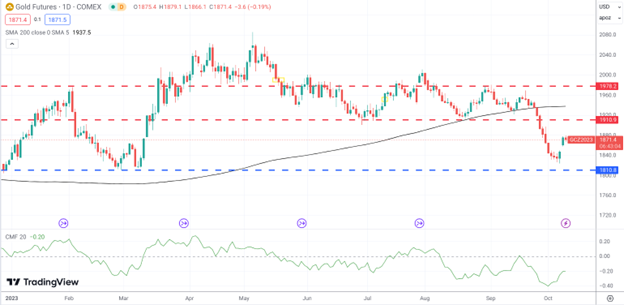What’s happening: Gold prices jumped over 1% yesterday (Monday, 10/9/23) in response to the escalating conflict between Israeli forces and Hamas in the Middle East.
How this impacts the markets: The mounting political uncertainty driven by the violence in the region has led people to flock to safe-haven assets like gold, as such assets are considered more stable during periods of geopolitical unrest.
More details:
- Israel intensified its offensive in the Gaza Strip on Sunday, resulting in hundreds of casualties. This action was in response to one of its bloodiest attacks when Hamas gunmen rampaged through Israeli towns.
- Spot gold peaked at $1,863 per ounce (high for 10/9/23), its highest in a week. U.S. gold futures similarly increased by 1% to $1877.
- This rise in geopolitical tension also impacted oil prices, pushing them higher. Demand increased for other safe-haven assets like U.S. Treasuries, the dollar, and the Japanese yen.
Keep in mind, though: UBS analysts note that while gold benefits from such geopolitical events in the short-term, high US interest rates could counteract these gains. Only if the Fed takes a more dovish stance by 2024 would gold prices likely see sustained increases.
Here’s what to watch: Wall Street is awaiting U.S. inflation data and minutes from the U.S. central bank’s September meeting, both of which could influence gold demand.
What analysts are saying: Geopolitical events can sometimes be a “noise event, causing short-term fluctuations in commodity prices, and none of which may be long-term drivers of prices. However, the matter may get worse before it gets better, and you can’t discount the possibility of other nations like Iran, Syria, or the U.S. entering the fray.
What’s the technical picture: It’s going to take a lot of momentum for gold futures (GC) to reverse course as it has plenty of headwinds on the horizon.

- The Israel conflict took place at a time when gold was about to test its yearly low (see blue dotted line).
- Gold bounced back before reaching this level but the big question is whether there will be any follow-through volume to generate sustained bullish momentum.
- The Chaikin Money Flow (CMF) indicates a significant drop in buying pressure as it’s well below the zero line.
- Gold price broke below the 200-day simple moving average, a critical indicator of the longer-term trend.
- Up ahead are two strong areas of resistance (see red dotted lines); trading into this area, gold would return to a range of market indecision, where it hovered for months.
The bottom line: If you’re swing trading this move up, you know your short-term targets (the 200-day SMA and two resistance levels). If you’re looking to trade a much longer uptrend, should it happen, you may consider scaling in your position carefully, adding more of a position as gold breaks above its levels of resistance, checking other indicators like volume and CMF to confirm the buying pressure, and, most importantly, staying on top of the news regarding the conflict in Israel and any other economic reports (like this week’s CPI and PPI) that can influence gold prices.
Please be aware that the content of this blog is based upon the opinions and research of GFF Brokers and its staff and should not be treated as trade recommendations. There is a substantial risk of loss in trading futures, options and forex. Past performance is not necessarily indicative of future results.
Disclaimer Regarding Hypothetical Performance Results: HYPOTHETICAL PERFORMANCE RESULTS HAVE MANY INHERENT LIMITATIONS, SOME OF WHICH ARE DESCRIBED BELOW. NO REPRESENTATION IS BEING MADE THAT ANY ACCOUNT WILL OR IS LIKELY TO ACHIEVE PROFITS OR LOSSES SIMILAR TO THOSE SHOWN. IN FACT, THERE ARE FREQUENTLY SHARP DIFFERENCES BETWEEN HYPOTHETICAL PERFORMANCE RESULTS AND THE ACTUAL RESULTS SUBSEQUENTLY ACHIEVED BY ANY PARTICULAR TRADING PROGRAM.
ONE OF THE LIMITATIONS OF HYPOTHETICAL PERFORMANCE RESULTS IS THAT THEY ARE GENERALLY PREPARED WITH THE BENEFIT OF HINDSIGHT. IN ADDITION, HYPOTHETICAL TRADING DOES NOT INVOLVE FINANCIAL RISK, AND NO HYPOTHETICAL TRADING RECORD CAN COMPLETELY ACCOUNT FOR THE IMPACT OF FINANCIAL RISK IN ACTUAL TRADING. FOR EXAMPLE, THE ABILITY TO WITHSTAND LOSSES OR TO ADHERE TO A PARTICULAR TRADING PROGRAM IN SPITE OF TRADING LOSSES ARE MATERIAL POINTS WHICH CAN ALSO ADVERSELY AFFECT ACTUAL TRADING RESULTS. THERE ARE NUMEROUS OTHER FACTORS RELATED TO THE MARKETS IN GENERAL OR TO THE IMPLEMENTATION OF ANY SPECIFIC TRADING PROGRAM WHICH CANNOT BE FULLY ACCOUNTED FOR IN THE PREPARATION OF HYPOTHETICAL PERFORMANCE RESULTS AND ALL OF WHICH CAN ADVERSELY AFFECT ACTUAL TRADING RESULTS.